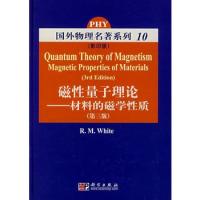網(wǎng)站首頁 > 圖書 > 電磁理論
| 定價: | ¥ 68 | ||
| 作者: | (英)懷特(White,R.M.) 主編 | ||
| 出版: | 科學(xué)出版社 | ||
| 書號: | 9787030209382 | ||
| 語言: | 英文原版 | ||
| 日期: | 2008-02-01 | ||
| 版次: | 1 | 頁數(shù): | 359 |
| 開本: | 16開 | 查看: | 313次 |

| 服務(wù)商城 | 客服電話 | 配送服務(wù) | 優(yōu)惠價 | 購買 |
| 400-711-6699 | 滿29至69元,免運費! | ¥55.6 |
本書從“線性響應(yīng)”出發(fā)研究磁學(xué)現(xiàn)象,主要內(nèi)容是研究磁性材料在磁場作用下是如何響應(yīng)的。書中不僅介紹了這些新現(xiàn)象,而且詳細討論了新材料(如高溫超導(dǎo)材料)的一個重要性質(zhì)——磁性。本書是一本介紹新材料科學(xué)關(guān)鍵性能——磁性的經(jīng)典著作。
本書從“線性響應(yīng)”出發(fā)研究磁學(xué)現(xiàn)象。主要內(nèi)容是研究磁性材料在磁場作用下是如何響應(yīng)的(磁場可以是均勻的或不均勻的,靜止的或變化的)。本書的前兩版主要研究了磁性響應(yīng),本版中還增加了磁性材料的磁阻抗,同時在每章后還增加了一些習(xí)題以幫助讀者加深對內(nèi)容的理解。本書關(guān)于磁學(xué)基本原理的論述和前兩版相比變化不大。隨著研究的深入和新應(yīng)用的發(fā)展,新的磁學(xué)現(xiàn)象不斷涌現(xiàn),如本書第二版出版以來,發(fā)現(xiàn)了巨磁阻效應(yīng),自旋電子學(xué)的研究隊伍也在迅速擴大。本書不僅介紹了這些新現(xiàn)象,而且詳細討論了新材料(如高溫超導(dǎo)材料)的一個重要性質(zhì)——磁性。我們通過測量磁化率,核磁共振,中子散射等手段來研究材料的磁性,這為新材料的研究提供了便利。根據(jù)最近的研究成果,本書對一些資料作了重要的修正,也新加入了一些資料(新加入了有關(guān)磁性多層薄膜的一章)。本書緊跟學(xué)科發(fā)展,是一本介紹新材料科學(xué)關(guān)鍵性能——磁性的經(jīng)典著作。
1 The Magnetic Susceptibility
1.1 The Magnetic Moment
1.2 The Magnetization
1.3 The Generalized Susceptibility
1.3.1 The Kramers-Kronig Relations
1.3.2 The Fluctuation-Dissipation Theorem..
1.3.3 Onsager Relation
1.4 Second Quantization
1.4.1 Example:The Degenerate-Electron Gas
1.4.2 Example:The Zeeman Interaction
2 The Magnetic Hamiltonian
2.1 The Dirac Equation
2.2 Sources of Fields
2.2.1 Uniform External Field
2.2.2 The Electric Quadrupole Field
2.2.3 The Magnetic Dipole(Hyperfine)Field.
2.2.4 Other Electrons on the Same Ion
2.2.5 Crystalline Electric Fields
2.2.6 Dipole-Dipole Interaction
2.2.7 Direct Exchange
2.2.8 Superexchange
2.2.9 Molecular Magnets
2.2.10 Double Exchange
2.2.11 Exchange on a Surface
2.3 The Spin Hamiltonian
2.3.1 Transition-Metal Ions
2.3.2 Rare-Earth Ions
2.3.3 Semiconductors
3 The Static Susceptibility of Noninteracting Systems
3.1 Localized Moments
3.1.1 Diamagnetism
3.1.2 Paramagnetism of Transition-Metal Ions
3.1.3 Paramagnetism of Rare-Earth Ions
3.2 Metals
3.2.1 Landau Diamagnetism
3.2.2 The de Haas-van Alphen Effect
3.2.3 Quantized Hall Conductance
3.2.4 Pauli Paramagnetism
3.3 Measurement of the Susceptibility
3.4 Local Moments in Metals
3.4.1 Virtual Bound States
3.4.2 Anderson's Theory of Moment Formation
3.4.3 The Kondo Effect
4 The Static Susceptibility of Interacting Systems:Local Moments
4.1 High Temperatures
4.2 Low Temperatures
4.3 Temperatures Near Tc
4.4 Landau Theory of Second-Order Transitions
4.5 Critical Phenomena
4.5.1 Order in 2D
4.6 Stoner-Wohlfarth Model
4.7 Dynamic Coercivity
4.8 Magnetic Viscosity
5 The Static Susceptibility of Interacting Systems:Metals.
5.1 Fermi Liquid Theory
5.2 Heavy Fermion Systems
5.3 Itinerant Magnetism
5.3.1 The Stoner Model
5.3.2 The Hubbard Model
6 The Dynamic Susceptibility of Weakly Interacting Systems:Local Moments
6.1 Equation of Motion
6.2 The Bloch Equations
6.3 Resonance Line Shape
6.3.1 The Method of Moments
6.3.2 The Relaxation-Function Method
6.3.3 Spin Diffusion
6.4 Spin Echoes
6.4.1 Measurement of T1
6.4.2 Calculation of T1
7 The Dynamic Susceptibility of Weakly Interacting Systems:Metals
7.1 Paramagnons
7.2 Fermi Liquid Theory
7.3 Conduction-Electron Spin Resonance
7.4 Spin Waves
7.5 Local Moments in Metals
7.6 Faraday Effect
8 The Dynamic Susceptibility of Strongly Interacting Systems
8.1 Broken Symmetry
8.2 Insulators
8.2.1 Spin-Wave Theory
8.2.2 Coherent Magnon State
8.2.3 Magnetostatic Modes
8.2.4 Solitons
8.2.5 Thermal Magnon Effects
8.2.6 Nonlinear Processes
8.2.7 Chaos
8.2.8 Optical Processes
8.3 High Temperatures
8.4 Micromagnetics
8.4.1 Magnetic Force Microscope
8.4.2 Phenomenological Damping
8.5 Metals
9 Thin Film Systems
9.1 Interfaces
9.1.1 Exchange Bias
9.1.2 Biquadratic Exchange
9.2 Trilayers
9.2.1 The RKKY Ineraction
9.2.2 Quantum Well Model
9.2.3 Giant Magnetoresistance(GMR)
9.2.4 Tunneling
9.2.5 Spin Transfer
9.2.6 Spin Hall Effect
10 Neutron Scattering
10.1 Neutron Scattering Cross Section
10.2 Nuclear Scattering
10.2.1 Bragg Scattering
10.2.2 Scattering of Phonons
10.3 Magnetic Scattering
10.3.1 Bragg Scattering
10.3.2 Spin Dynamics
10.4 Example:Manganese Oxides
10.5 Example:Quantum Phase Transitions
References
Index





 粵公網(wǎng)安備 44030902003195號
粵公網(wǎng)安備 44030902003195號